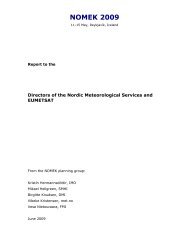International Symposium on Mitigative Measures against Snow ...
International Symposium on Mitigative Measures against Snow ...
International Symposium on Mitigative Measures against Snow ...
You also want an ePaper? Increase the reach of your titles
YUMPU automatically turns print PDFs into web optimized ePapers that Google loves.
<str<strong>on</strong>g>Internati<strong>on</strong>al</str<strong>on</strong>g> <str<strong>on</strong>g>Symposium</str<strong>on</strong>g> <strong>on</strong> <strong>Mitigative</strong> <strong>Measures</strong> <strong>against</strong> <strong>Snow</strong> Avalanches<br />
Egilsstaðir, Iceland, March 11–14, 2008<br />
and utilisati<strong>on</strong> of hazard z<strong>on</strong>es, and preparati<strong>on</strong> of provisi<strong>on</strong>al hazard z<strong>on</strong>ing (Icelandic<br />
Ministry for the Envir<strong>on</strong>ment, 2000) which is under c<strong>on</strong>stant revisi<strong>on</strong>, the last <strong>on</strong>e in 2007.<br />
Extensive research <strong>on</strong> avalanches and protecti<strong>on</strong> measures and acquired experience of<br />
structural design and c<strong>on</strong>structi<strong>on</strong>s of avalanche defences has also lead to improvements in<br />
the design of the defence structures (SATSIE, 2006).<br />
2. DESIGN PROCESS<br />
In Iceland local communities represent the buyer of avalanche defences. The bulk of the<br />
financial c<strong>on</strong>tributi<strong>on</strong> is originated from the Icelandic Avalanche and Landslide fund and<br />
project management is carried out by the Government C<strong>on</strong>structi<strong>on</strong> C<strong>on</strong>tracting Agency<br />
(GCCA) (Framkvæmdasýsla ríkisins).<br />
Avalanche hazard is assessed by the Icelandic Meteorological Office (IMO) prior to designing<br />
avalanche protecti<strong>on</strong> and presented and attested by individual Hazard Z<strong>on</strong>ing Committees.<br />
Technical reports and hazard z<strong>on</strong>ing maps are evidently the main input when designing<br />
avalanche defences. Technical reports describe topographic and climatic c<strong>on</strong>diti<strong>on</strong>s and<br />
assessment <strong>on</strong> avalanche hazard based <strong>on</strong> model estimates.<br />
The design process of avalanche protecti<strong>on</strong> measures can be divided into four stages: 1)<br />
Appraisal study 2) Envir<strong>on</strong>mental impact assessment (EIA) 3) Technical design 4)<br />
C<strong>on</strong>structi<strong>on</strong> and supervisi<strong>on</strong>.<br />
Protecti<strong>on</strong> structures can have striking visual impact <strong>on</strong> towns and hillsides, leading to<br />
negative discussi<strong>on</strong> and criticism. Landscape architects have therefore increasingly been<br />
involved in the design process at an early stage. This has often lead to successful integrati<strong>on</strong><br />
of defence structures into the envir<strong>on</strong>ment in additi<strong>on</strong> to creating attractive outdoor and<br />
recreati<strong>on</strong>al areas for public use. The inhabitants involved should furthermore be kept<br />
informed and involved at all stages of the design. Such successful integrati<strong>on</strong> al<strong>on</strong>g with the<br />
added number of occasi<strong>on</strong>s when the protecti<strong>on</strong> dams have proven useful in deflecting or<br />
c<strong>on</strong>trolling avalanches has helped to reduce negative criticism.<br />
3. PROTECTION ALTERNATIVES<br />
Avalanche protecti<strong>on</strong> structures are c<strong>on</strong>sidered as a permanent c<strong>on</strong>trol <strong>against</strong> avalanches,<br />
preventing damage to residential properties as well as casualties or accidents. Supporting<br />
structures are installed to support the snow pack in the starting z<strong>on</strong>es. They are usually made<br />
of steel. Two basic types include bridges (rigid steel barriers) and snow nets. Grounding<br />
c<strong>on</strong>diti<strong>on</strong>s and risk of rock fall are ruling factors when determining which type of supporting<br />
structures should be selected. Deflecting dams are the most favorable type of protecti<strong>on</strong><br />
structures in the runout z<strong>on</strong>e (McClung and Schaerer, 1993, SATSIE, 2006). Deflecting dams<br />
are most frequently c<strong>on</strong>structed as simple earth-fill dams with heights up to 20 m. The<br />
steepness of the slopes is subject to the soil properties of the earth fill. Catching dams are<br />
c<strong>on</strong>structed perpendicular to avalanche paths and functi<strong>on</strong> as arresters (McClung and<br />
Schaerer, 1993, SATSIE, 2006). Most catching dams are earth-fill dams and many are<br />
designed with steep fr<strong>on</strong>t c<strong>on</strong>structed with the aid of earth reinforcement systems or c<strong>on</strong>crete.<br />
The dams have been built up to 20 m high. Braking mounds or retarders are located in<br />
avalanche paths in order to dispatch the energy of the avalanche and reduce its speed<br />
(Hak<strong>on</strong>ardottir and others, 2003). The mounds have been built in staggered rows up to 10 m<br />
Indriðas<strong>on</strong>, Sigurðss<strong>on</strong>, Tómass<strong>on</strong> and Hák<strong>on</strong>ardóttir 125











